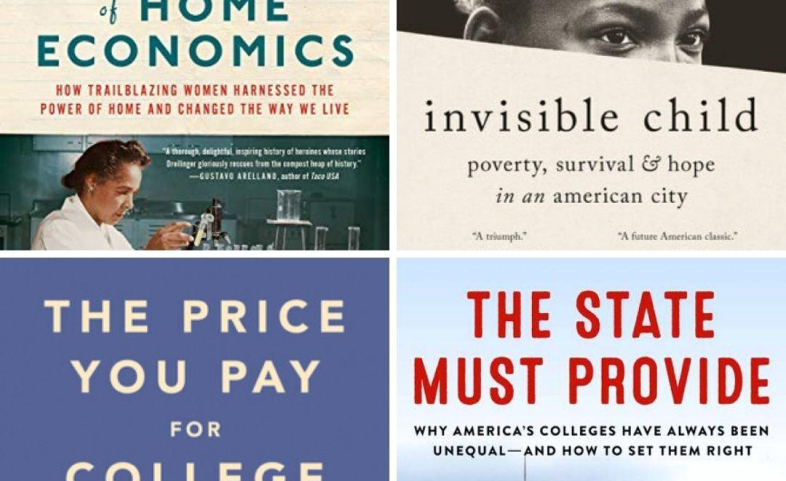
These New Education Books Make Perfect Gifts. (Trust Us.)
What we’re giving the education reporters (and education enthusiasts) on our list this year.
Photo credit: Book photos from authors

What we’re giving the education reporters (and education enthusiasts) on our list this year.
Photo credit: Book photos from authors
Shopping for the education writer in your life this holiday season? Any reporter can tell you which is the best seat in the school board meeting room: It’s the one near the only working wall outlet. While this popular version of a portable battery pack will set you back about $50, it’s reliable, durable, and speedy. (No, EWA does not do paid product endorsements. I actually use this.) It also has the benefit of being cable free if your gift recipient uses a compatible smartphone.
And despite the many wonders of the smartphone, reporters still love their notebooks. For a thrifty and practical gift, take a look at The Reporter’s Notebook, created by longtime EWA member Nic Garcia. They’re perfectly designed and come in a set of 10 for $25.
Reporters are putting in long hours these days, and it’s more important than ever to stay hydrated. Kim Clark, EWA’s deputy director for higher education, sings the praises of reusable, collapsible water bottles like this one. They’re good for the environment, as well. But, as she reminded me: try and buy directly from the company if you’re looking for something durable, and be careful of the cheap knock-offs.
Fact: I’d rather get books for gifts than just about anything else. Here’s a short list of recommendations gleaned from EWA members (including some titles by EWA members) that are sure to please the reporters and education enthusiasts on your “Nice” list:
John U. Bacon
In this lively and uplifting journey, sports journalist John U. Bacon returned to his alma mater (Huron High School in Ann Arbor, Michigan) to coach the River Rats, the school’s ice hockey team. In helping the team come together on and off the ice, Bacon rediscovers the value of both physical and mental preparation for competition. But he also does a fine job bringing the cast of characters – many of them teenaged boys – vividly into focus. As any education writer can tell you, that takes both patience and skill.
Danielle Dreilinger
Who invented the school lunch? Why did generations of students have to sew potholders and pillowcases? And how did home economics help push open the doors to higher education for women? Longtime education journalist Dreilinger digs into the fascinating – and largely forgotten – history of what was once a staple of the public school curriculum. The New Yorker praised her work as “deeply researched and crisply written.” (And indeed it is.)
Andrea Elliott
Pulitzer-Prize winner Elliott of The New York Times spent nine years following the life of Dasani, a Black girl battling poverty, homelessness, and racism. It’s a searing, painful, and unforgettable odyssey. Elliott’s work is also a master class in narrative journalism, and one that is likely to stand alongside classics of the genre by writers like Alex Kotlowitz and Tracy Kidder.
Adam Harris
Harris, a staff writer for The Atlantic and an expert on the higher ed beat, uses rich narratives and meticulous historical research to show how segregation and inequity have held back generations of Black students. But the book is as much a story about some of the individuals whose lives were shaped by their realities as it is a history lesson, which makes for a gripping read.
Ron Lieber
An experienced personal finance reporter for The New York Times, Lieber relied on 15 years of expertise to craft this trenchant roundup, which informs both consumers (students and families) as well as others. For education journalists, it’s a thoughtful distillation of the complex formulas that make up college costs. And the better reporters understand the math and return-on-investment factors at play, the better job they’ll do explaining these issues to their audiences.
Josh Mitchell
Mitchell, a veteran Wall Street Journal reporter who has long been covering student debt issues, lays bare the fascinating and – sometimes distressing – history of how we got to a student debt load of $1.7 trillion.
Amanda Ripley
Ripley, whose education writing is known for its insights and thought-provoking analysis, tackles some questions here: What turns healthy disagreements into unhealthy conflict, and how do we resolve them? Her book offers a blueprint for understanding how self-righteousness and assumptions undermine our interpersonal relationships as well as solutions from experts and researchers. While not an “education” book per se, it’s relevant to understanding many of the underlying issues driving controversies in K-12 and higher education spheres these days.
Clint Smith
One of the many beautiful things about Smith’s book is how accessible it is; he is equal parts historian and teacher as he shows us how landmarks and memorial sites often fail to portray an accurate picture of historical events and their context. Many students get their first closeup look at U.S. history through school tours like the ones Smith describes. That’s what makes this book vital reading for education journalists who want a better understanding of what – and how – young people are being taught about the nation’s complex and painful intergenerational history of slavery.
Andy Thomason
Thomason, assistant managing editor at The Chronicle of Higher Education, went deep into the 2011 scandal at the University of North Carolina-Chapel Hill, in which student athletes were enrolled in fake classes in order to fudge their eligibility to compete. What’s been learned about safeguarding student athletes in the decade since? Not enough, Thomason argues. (Disclosure: Colleen Murphy, an education journalist and also an EWA member, kindly bumped the book up on my radar.)
Your post will be on the website shortly.
We will get back to you shortly